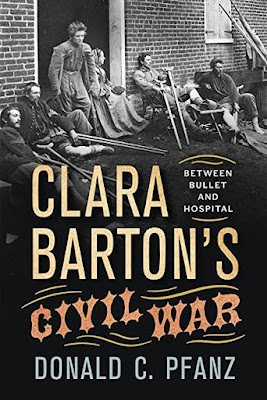The obvious purpose of Civil War-era’s
minie ball was to inflict damage. The soft lead bullet traveled at a relatively
slow speed (about 950 feet per second) compared to present-day military rifle
projectiles. However, the size and weight of the bullet added significantly to
its ability to produce grievous wounds. Measuring over half an inch in
diameter, and weighing just over an ounce, the spinning motion created by the
rifling inside the musket’s barrel helped ensure the missile flew accurately
and carried a serious amount of kinesthetic energy. Upon impact the bullet
often flattened and or tumbled causing tremendous destruction to human tissue
and bone. It is a wonder that as many soldiers wounded in Civil War combat ultimately
survived. Of course, those men who received wounds to the body’s extremities
had a better chance of living than those injured in the core of the body or
head.
During the Battle of New Market Heights,
Pvt. William R. Wright, Co. B, 5th United States Colored Infantry
(USCI) charged forward with his comrades. As the assault stalled near the rows
of abatis, and within easy rifle range of the Texas Brigade defenders, the
attacking soldiers fell in droves, wounded in every conceivable manner. It is highly
likely that Pvt. Wright received the gunshot wound that perforated his chest at
this point in the battle.
William Roy Wright entered this world
about 1832 under unfavorable circumstances. It unknown whether he was born
enslaved or free. Regardless, he was born in Caroline County, Virginia, a slave
state that placed significant restrictions on both enslaved and free people of
color. By 1850, William Wright was a resident in the free state of Ohio. He
appears in that year’s census in Chillicothe, Ross County, as an 18-year old
living in household of Joseph Wright, who was likely William’s older brother, as
Joseph was only 29 years old. William’s listed occupation is laborer, and he is
described as “mulatto.” A decade later, William was head of his own household.
His wife, Mary, and young children, Louis A., James, and William B., formed the
family’s circle. William was not a wealthy man. He only claimed $20.00 in
personal property. Interestingly, in the 1860 census, Wright and his family are
described as “black.”
Perhaps having such a young family discouraged
William from enlisting earlier. And maybe it was his financial circumstances
which finally motivated William to join Company B, 5th USCI on
August 17, 1864, as by that point in the war the government had equalized pay
between black and white soldiers. A 32-years old, he was a little older than
the average soldier. Before enlisting he worked as a carpenter.
While many of his 5th USCI
comrades had participated in raids in southeastern Virginia and fought in the
opening attacks of the Petersburg Campaign, Pvt. Wright was a true “fresh fish”
when thrown into battle on September 29, 1864, at New Market Heights. Having traveled
hundreds of miles from Ohio to join the regiment, Wright was only a soldier for
about a month and 12 days before he received his first and only taste of
combat.
Pvt. Wright may have first received medical
attention near the battlefield from Sister Lydia Penny, the wife of 5th
USCI soldier Thomas Penny. “There she could be seen, the only woman present,
like an angel from above, giving words of cheer, and doing all in her power to
relive the suffering of the wounded and dying,” wrote a black soldier.
Placed on hospital transport ships at
Deep Bottom landing on the James River, and then evacuated to hospitals at
Point of Rocks, Fort Monroe, and Portsmouth, Virginia, the injured received
treatment for their various wounds. For some soldiers there was not much the surgeons
could do. In cases like Pvt. Wright’s where wounds occurred to the chest,
medical science’s limitations were clearly evident. It is probably a testament
to Wright’s will to survive that he lived as long as he did with such a severe
wound. However, he finally succumbed to death on November 22, 1864.
Mary Wright filed for a widow’s pension
and received $8.00 per month and an additional $2.00 per month per child until
they turned 16 year old to help her and William’s young children. The pension
file records that the couple had two additional boys since the 1860 census;
John and Leroy. However, one can only imagine the heartbreak they must have
felt learning of the wounding and death of their husband and father so soon
after he left their hearth and home for the war.
Today, Pvt. Wright rests in peace in grave
number 2844 in the Hampton National Cemetery. We honor you for your service and
for sacrificing of your life in the effort to move the United States closer
toward a “more perfect Union.”




























